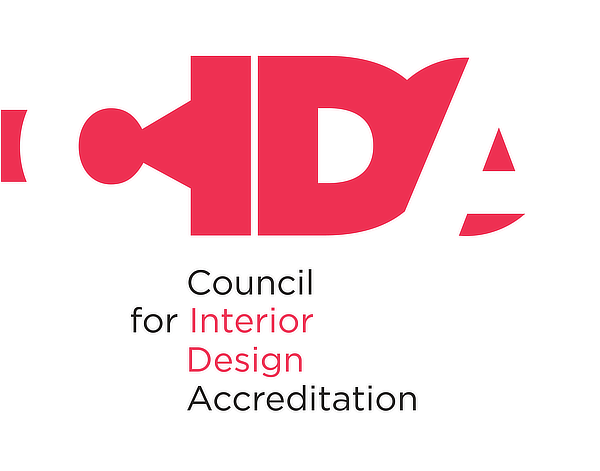
Brooke Cuthbertson ’24
Interior Design Major’s Honors Thesis Draws on Her Father’s Military Background
The average person spends up to 90 percent of their time indoors, so interior environments have the potential to make a big impact. Our surroundings can affect our thoughts, feelings, behavior, and productivity. It’s an interior designer’s job to consider how color and contrast work alongside acoustics and lighting to create ideal environments in which to live, relax, and work.
The University of New Haven interior design program leading to the Bachelor of Fine Arts in Interior Design with a General or Pre-Architecture concentration is accredited by the Council for Interior Design Accreditation, www.accredit-id.org, 206 Cesar E. Chavez Ave SW, Suite 350, Grand Rapids, MI 49503.
Of graduates employed employed in interior design or a related profession within six months of graduation (Class of 2022)
Of students graduated in four years (Class of 2022)
First-year students retained for second year (Class of 2022)
Our faculty are leaders and innovators in their fields, bringing both deep professional experience and academic rigor to the classroom.

Interior Design Major’s Honors Thesis Draws on Her Father’s Military Background

I learned to be more confident in my ability and to trust that I really do have a firm grasp on my future in this field.

Range of experiences leads to career in healthcare interior design.
The information below is designed to show the many possible careers you could pursue with your major. The research is provided by Encoura, the leading research and advisory firm focused exclusively on higher education. It includes median national salaries and industry growth projections over the next decade. Click here to view the full report.
Lighting Designer
7% Growth 2017-2027
Territory Sales Manager
9% Growth 2017-2027
Sales Representative
9% Growth 2017-2027
This course surveys the use of lighting, both natural and artificial, as a design element in planning residential and commercial interiors. The impact of perception, psychology, brightness, color, and daylight are discussed. Interior lighting products including incandescent and discharge lamps are studied in detail along with auxiliary equipment, light controls, photometrics, electricity, and luminaries. Laboratory fee.
This course advances the student’s basic drawing and illustrative skills through the exploration of quick sketching and rendering techniques for architectural and interior spaces. A variety of media will be studied including markers, pastels, color pencils, watercolor, pencil, pen, etc. Focus is on the application of the media to create visual expression of the exterior and interior elements.
This course introduces students to all elements of the preparation, development, and production of a complete set of construction documents for residential and commercial interior spaces including project evaluation and an in-depth understanding of document requirements, method applications, blueprint reading, specification writing, drawing nomenclature, and millwork requirements. An emphasis is placed upon the development of accurate descriptive drawing notes, specifications, dimensioning, and symbols within the construction documents. Building codes and ADA issues are explored as applicable to individual projects.
This course explores the design and construction requirements for interior building elements and environmental systems. Issues related to interior finishes, sustainability resources, and green design are explored. Building codes, fire codes, and ADA compliance relative to the built interior environment are studied through the use of construction documents and study models.
The University of New Haven offers a wide variety of in-depth courses that create a transformational educational experience for our students. To view the complete list of courses you'll take while pursuing a Bachelor of Arts in Interior Design & Pre-Architecture, check out the Academic Catalog:
Interior Design, B.F.A. - General Concentration
Get an inside look at what differentiates the University of New Haven and how your experiences as a student will prepare you for success.



All University of New Haven students have access to the many resources available through the University’s Career Development Center, which has been named one of the best in the nation by The Princeton Review.
From career assessments, networking, and job shadowing to on-campus interviews and salary negotiation, the Career Development Center provides the skills and connections to identify a meaningful career and an opportunity to pursue your passion.
Learn More
The University of New Haven interior design program leading to the Bachelor of Fine Arts in Interior Design with a General or Pre-Architecture concentration is accredited by the Council for Interior Design Accreditation, www.accredit-id.org, 206 Cesar E. Chavez Ave SW, Suite 350, Grand Rapids, MI 49503.
The CIDA-accredited program prepares students for entry-level interior design practice, for advanced study, and to apply for membership in professional interior design organizations. The Bachelor of Fine Arts in Interior Design with a General or Pre-Architecture concentration granted by University of New Haven meets the educational requirement for eligibility to sit for the National Council for Interior Design Qualification Examination (NCIDQ Exam). For more information about NCIDQ Exam eligibility visit: https://www.cidq.org/eligibility-requirements.
Learn More About CIDA CIDA Video
The University of New Haven has achieved the National Association of Schools of Art & Design (NASAD) accreditation. This mark of excellence designates the University's B.A. in Art and B.F.A. programs in Graphic and Digital Design, and Interior Design as nationally accredited programs.
Founded in 1944, NASAD is an organization of schools, conservatories, colleges, and universities with approximately 360 accredited institutional members. It establishes national standards for undergraduate and graduate degrees and other credentials for art and design and art/design-related disciplines, and provides assistance to institutions and individuals engaged in artistic, scholarly, educational, and other art/design-related endeavors.
Learn More
The Charger Blog
Students studying abroad at the University’s campus in Prato, Italy, are big fans of Sports Night, an activity-filled evening that brings together students, faculty, and staff for fun and connection outside the classroom.
There are a variety of opportunities for you to learn more about our programs, what it is like to be a student here, and the scholarships, assistantships and financial aid that we offer. Whether you want to meet us on campus or online, we have something for you.
Whether you're still in high school or are transferring from another college, we offer full- and part-time opportunities for undergraduates from inside the U.S. and abroad. The admission process can begin as early as the end of your high school junior year.
The Application Process
We offer a comprehensive financial aid program, with students receiving assistance in the form of grants, scholarships, student loans, and part-time employment. Funds are available from federal and state governments, private sponsors, and from university resources. More than 85 percent of the University's full-time undergraduate students receive some form of financial assistance.
Learn More
In the University’s BFA in Interior Design program students can start the path towards becoming a Certified Interior Designer. Specific education and work experience requirements exist to be eligible to sit for the NCIDQ Examination. Students that complete this are eligible to sit for the National Council for Interior Design Qualification (NCIDQ) examination.
For the BFA Interior Design program:
The following states do not regulate Interior Design licensure: AK, AZ, CO, DE, HI, ID, KS, MA, MI, MT, NE, NH, ND, OH, OR, PA, RI, SC, SD, VT, WA, WV and WY.
Please note that we are currently working through the states' requirements and will update this information as we make the determinations. Students who are interested in working in any of these states are strongly encouraged to contact the appropriate state board to confirm that jurisdiction’s requirements.
Click the link below for contact information on State licensure boards.
Click here for more information on Licensure & Professional Certification Disclosures.